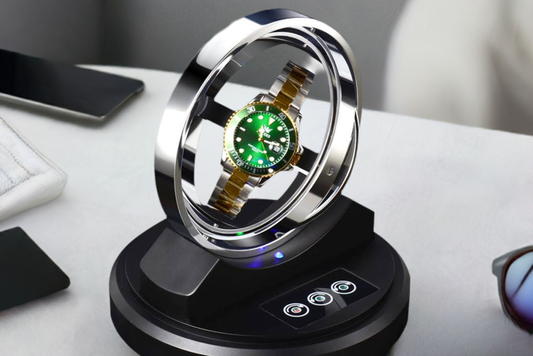Removing a winder from a watch can be a delicate and intricate process, but with the right knowledge, tools, and techniques, you can successfully tackle this task. In this comprehensive guide, we'll walk you through the various methods and considerations for safely detaching the crown and stem from different types of watches, including mechanical, quartz, and vintage pieces. By the end of this article, you'll have the confidence and expertise to handle this process with ease.
Understanding Watch Winders: Basics and Types
Before diving into the removal process, it's crucial to understand the basics of watch winders and the different types of crowns and movements involved.
Crown Types: Exploring Push-Style, Screw-Down, and Traditional Crowns
Watch crowns come in three primary types:
-
Push-Style Crown: The most common type, found on quartz and some mechanical watches. It features a simple push-pull mechanism for setting the time and date. To remove the stem, pull the crown out to the time-setting position and gently pull it away from the case.
-
Screw-Down Crown: Designed for enhanced water resistance, commonly found on diving watches. To remove the stem, unscrew the crown by turning it counterclockwise, then pull it out to the time-setting position and remove the stem.
-
Traditional Crown: Also known as a pull-out crown, typically found on mechanical watches. It requires pulling the crown out to different positions to set various functions. To remove the stem, pull the crown out to the time-setting position and gently pull it away from the case.
Credit: YouTube Channel - Watch Repair Channel
Watch Movements: How Mechanical, Automatic, and Quartz Movements Affect Stem Removal
The type of watch movement also plays a role in the stem removal process:
-
Mechanical Movement: Powered by a hand-wound mainspring. The stem removal process involves pulling the crown out to the time-setting position and gently pulling the stem away from the case.
-
Automatic Movement: Also known as a self-winding movement, powered by the wearer's movements. The stem removal process is similar to that of mechanical watches.
-
Quartz Movement: Battery-powered and regulated by a quartz crystal. Quartz watches often have a simpler stem removal process, as the stem is typically not connected to a mechanical gear train. Pull the crown out to the time-setting position and gently pull the stem away from the case.
Safety First: Tools and Precautions for Removing a Winder from a Watch
To ensure a safe and successful winder removal, you'll need the right tools and precautions:
Essential Tools for Removing a Winder
-
Tweezers: Use high-quality tweezers with a fine tip and comfortable grip to handle small parts and grip the winder stem. Prices range from $10 to $30.
-
Screwdrivers: Invest in a set of watch screwdrivers, including flathead and Phillips-head drivers in various sizes. Prices range from $20 to $50.
-
Magnification: A magnifying glass or loupe is essential for a clear view of the small components. Prices range from $10 to $50.
Tips for Avoiding Damage to Your Watch
-
Cleanliness: Ensure a clean, dust-free workspace to prevent debris from entering your watch.
-
Handle with Care: Always handle your watch with care, as the components are delicate and easily damaged. Avoid touching internal parts with bare hands.
-
Avoid Force: Never apply excessive force when removing the winder, as this can damage the stem or surrounding components. Work gently and patiently.
-
Consult a Professional: If you're not confident in your ability to remove the winder safely, consider consulting a professional watch repair service.
Method 1: Removing a Standard Watch Stem
Step 1: Identifying the Dimple
Locate the internal release mechanism, or dimple, usually a small, recessed area near the stem. Use a watchmaker's pusher or a small, blunt object to press the dimple firmly, releasing the internal mechanism that holds the stem in place.
Step 2: Loosening the Stem
For push-style stems, insert a watch repair screwdriver blade into the gap between the stem and the case. Gently pry the stem away from the case by turning the screwdriver clockwise to loosen the stem.
Step 3: Gentle Extraction
Hold the watch case firmly and gently slide the stem out of its socket. Apply consistent pressure to avoid excessive force, which can damage the stem or case. Note any additional components that may need to be removed or reinstalled.
Method 2: Screw-Down Crown Removal
Unlocking the Screw: Proper Technique for Counterclockwise Rotation
- Identify the screw that holds the crown in place, usually found on the side of the watch case near the crown.
- Hold the watch securely with the crown facing upwards.
- Apply gentle pressure to the crown using your thumb or a soft cloth to ensure it doesn't move out of place.
- Slowly rotate the crown counterclockwise using your fingers or a specialized tool until the screw begins to loosen.
Easing the Stem Out: Post-Screw Removal Steps
- Once the screw is removed, gently pull the stem out of the case, being cautious not to apply excessive force.
- Inspect the stem for debris or residue and clean if necessary.
- If reassembling, ensure the stem is properly aligned and the screw is securely tightened in a clockwise direction.
Handling Complicated Movements
Vintage Watches: Special Considerations for Older Mechanisms
- Identify the movement type: Consult documentation or search online for specific information about the vintage watch model to identify the movement type.
- Use appropriate tools: Vintage watches often require specialized tools designed for the specific movement type to avoid damage.
- Be gentle and patient: Handle vintage watches with care, as they are often more fragile than modern counterparts. Work slowly and methodically.
- Consult online resources: Utilize online forums and communities dedicated to vintage watch collectors for guidance on removing the winder from specific models.
Seiko & Miyota: Unique Stem and Crown Detachment for These Popular Movements
Seiko Movements (e.g., 7S26, 4R36)
- Identify the stem type (standard 3.5mm or larger 4.5mm for diver's watches).
- Use a Seiko stem removal tool, available from watch repair suppliers and online retailers.
- Apply gentle pressure while turning the tool counterclockwise to release the stem and crown.
Miyota Movements (e.g., 9015, 8215)
- Identify the stem type (standard 3.5mm or larger 4.5mm for diver's watches).
- Use a Miyota stem removal tool, available from watch repair suppliers and online retailers.
- Apply gentle pressure while turning the tool counterclockwise to release the stem and crown.
Troubleshooting Common Issues
Stuck Stems: Strategies for When the Stem Won't Budge
- Clean the Stem and Crown: Use a soft-bristled toothbrush and mild soap solution to clean the stem and crown, loosening any debris preventing free movement.
- Apply Heat: Use a hair dryer or warm cloth to apply gentle heat to the stem and crown, softening hardened lubricants.
- Use a Stem Removal Tool: Apply gentle pressure using a specialized stem removal tool, such as the Bergeon 61110 ($25), to protect the watch's internal components.
- Apply Penetrating Oil: Apply a few drops of penetrating oil (e.g., WD-40 or Liquid Wrench) to the stem and let it sit for a few hours to break down corrosion.
Damage Prevention: What to Do If You Encounter Resistance
- Avoid Using Force: Never use force to remove a stuck stem, as this can damage the watch's internal components.
- Check for Obstructions: Inspect the stem and crown for dirt, dust, or old lubricants causing resistance, and clean them out before attempting removal again.
- Use the Correct Tools: Ensure you have the right tools for the job, such as a stem removal tool or watch case opener, to avoid damaging the watch.
- Consult a Professional: If unsure or encountering resistance, consult a professional watchmaker for their expertise and tools.
Professional Tips and Tricks
Insider Techniques from Expert Watchmakers
- Identify the Type of Winder: Determine if your watch has a screw-in crown (requires a specialized tool) or a push-pull crown (can be removed by pulling).
- Prepare Your Tools: Use clean, specialized tools in good condition, such as a crown wrench or watch case opener for screw-in crowns, or a soft cloth or watch repair mat for push-pull crowns.
- Remove the Crown: For screw-in crowns, use a crown wrench or watch case opener to gently turn counterclockwise. For push-pull crowns, pull the crown out slowly and carefully.
- Release the Stem: Pull the stem out slowly while turning it counterclockwise, avoiding touching it with bare hands to prevent damage from skin oils.
- Clean and Inspect: Clean the area with a soft cloth and inspect the watch for damage or debris. Take the opportunity to clean and lubricate the watch's internal mechanisms.
When to Seek Professional Help
- Complex Watches: Seek professional help for high-end or complex watches with intricate mechanisms that require specialized tools and techniques.
- Water Resistance: Ensure proper removal and replacement of the winder by a professional watchmaker to maintain the watch's water resistance.
- Damaged or Corroded Parts: If you notice any damaged or corroded parts during removal, seek professional help for assessment and replacement.
- Lack of Experience: If you're not comfortable with the removal process or lack experience with watch repair, seek guidance from a professional watchmaker.
Maintenance and Aftercare
Cleaning the Stem and Crown
- Gently grasp the crown with a soft cloth or specialized watch cleaning tool to avoid scratching the surface.
- Use a mild soap solution or watch cleaning solution (e.g., Bergeon 5501 Watch Cleaning Solution, $15.95 on Amazon) to gently scrub the crown and stem.
- Rinse the area thoroughly with distilled water to remove soap residue.
- Use a soft-bristled toothbrush or watch cleaning brush (e.g., Ofrei Watch Cleaning Brush, $12.95 on Ofrei.com) to gently sweep away remaining dirt or debris.
Reassembly Tips for a Secure Fit
- Carefully align the stem and crown, noting the grooves and notches for proper alignment.
- Gently push the stem into the watch case, ensuring it is fully seated to prevent movement or play.
- Apply a small amount of watch lubricant (e.g., Moebius 8211 Watch Lubricant, $14.95 on Amazon) to the stem and crown to reduce friction and prevent wear.
- Screw the crown back into place, ensuring it is securely fastened to prevent water ingress or other environmental factors from affecting the watch movement.
Conclusion
Removing a winder from a watch requires patience, precision, and a thorough understanding of the components involved. By following the steps outlined in this guide and using the recommended tools and materials, you can successfully remove the winder and ensure a secure reassembly of your watch. Remember to handle the components with care, as improper handling can lead to damage or malfunction. If you're ever in doubt, don't hesitate to consult a professional watchmaker to safeguard your valuable timepiece.
We hope this comprehensive guide has provided you with the knowledge and confidence to tackle the winder removal process. If you found this article helpful, please share it with your fellow watch enthusiasts and leave a comment below with your experiences or any additional tips you may have. Happy watch maintenance!
Frequently Asked Questions
1. Can I remove the winder from my watch at home, or do I need to take it to a professional?
In many cases, you can remove the winder from your watch at home using the proper tools and techniques. However, if you have a high-end, complex, or vintage watch, or if you're unsure about the process, it's always best to consult a professional watchmaker to avoid damaging your timepiece.
2. What tools do I need to remove the winder from my watch?
The essential tools for removing a winder include high-quality tweezers, a set of watch screwdrivers (flathead and Phillips-head), and a magnifying glass or loupe. Depending on your watch type, you may also need specialized tools such as a stem removal tool, crown wrench, or watch case opener.
3. How do I know if my watch has a push-style, screw-down, or traditional crown?
Push-style crowns are the most common and are found on many quartz and mechanical watches. They have a simple push-pull mechanism for setting the time and date. Screw-down crowns, designed for better water resistance, are often found on diving watches and must be unscrewed before pulling out the crown. Traditional crowns, also known as pull-out crowns, are typically found on mechanical watches and require pulling the crown out to different positions to set various functions.
4. What should I do if the stem is stuck and won't budge?
If the stem is stuck, try the following strategies:
- Clean the stem and crown with a soft-bristled toothbrush and mild soap solution to remove debris.
- Apply gentle heat using a hair dryer or warm cloth to soften hardened lubricants.
- Use a specialized stem removal tool to apply gentle pressure while protecting the watch's internal components.
- Apply a few drops of penetrating oil to the stem and let it sit for a few hours to break down corrosion.
If these methods don't work, or if you encounter significant resistance, consult a professional watchmaker to avoid damaging your watch.
5. How do I maintain my watch after removing and reinstalling the winder?
After removing and reinstalling the winder, it's essential to clean the stem and crown using a mild soap solution or specialized watch cleaning solution, and then rinse thoroughly with distilled water. Use a soft-bristled toothbrush or watch cleaning brush to remove any remaining dirt or debris. When reassembling, apply a small amount of watch lubricant to the stem and crown to reduce friction and prevent wear. Ensure the crown is securely fastened to maintain water resistance and protect the watch movement from environmental factors.




